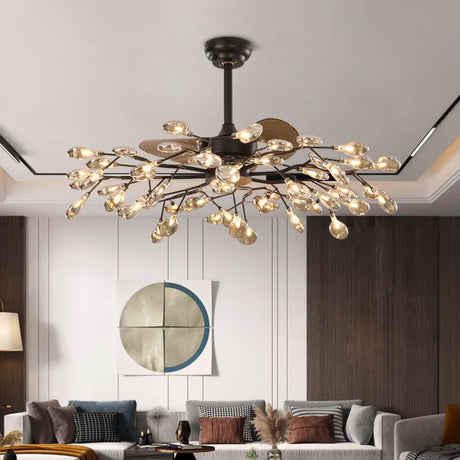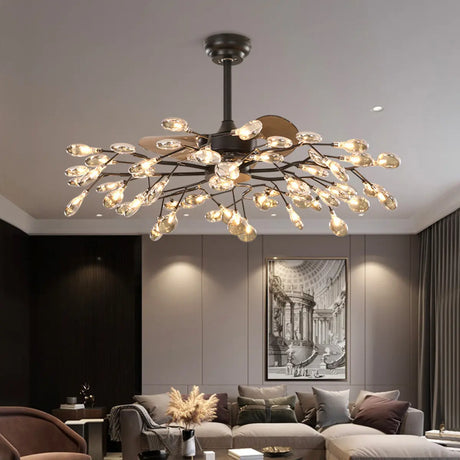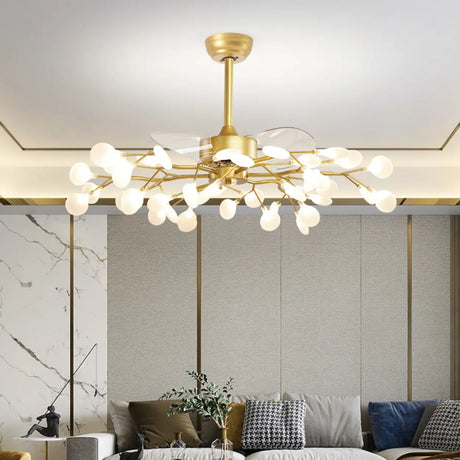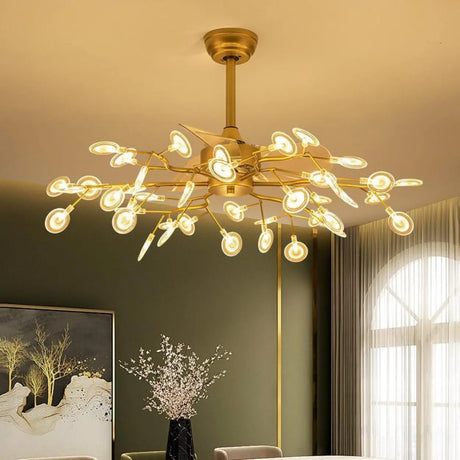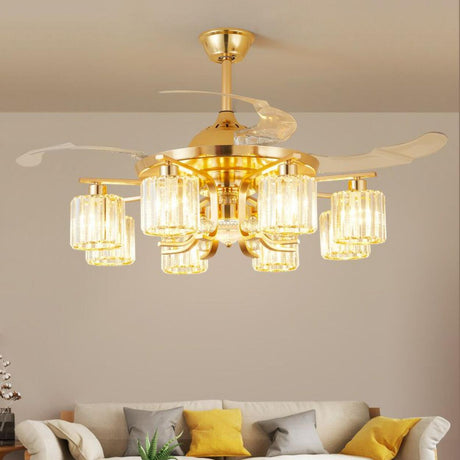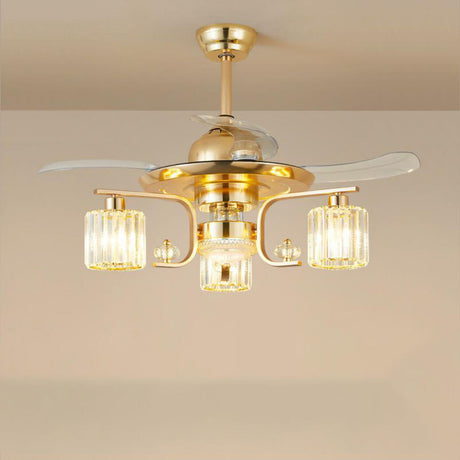Want a ceiling fixture that looks like a chandelier but cools like a fan? Meet the fandelier.
This quick guide covers what is fandelier, how they work, and whether they're actually worth buying. No fluff - just the facts you need to decide.
Table of Contents
What Exactly is a Fandelier?
A fandelier is short for "fandelier ceiling fan." As the name suggests, it combines a chandelier and ceiling fan into one fixture.
They come in three main styles:
Crystal fandeliers

These look like traditional crystal chandeliers when the fan is off. The blades retract completely into the fixture or hide behind crystal elements. Popular in dining rooms and formal living spaces.
Modern fandeliers

The fan blades are designed as decorative arms extending from a central light fixture. They stay visible but blend with contemporary or industrial decor. Often feature sleek metal finishes.
Rustic fandeliers

Wooden blades are crafted to look like natural chandelier elements - think wagon wheel designs or barn-style fixtures. The blades complement farmhouse and traditional country interiors.
Most models include LED lighting and separate controls for fan and lights.
Benefits of fandeliers
Space Saving You only need one ceiling fixture instead of buying a chandelier plus a separate fan.
Aesthetic Appeal They don't look like typical ceiling fans. Your room keeps its style when the fan is off.
Dual Function You get both ambient lighting and air circulation from one purchase.
Property Value Higher-end models can add to your home's appeal, especially in dining rooms and master bedrooms.
How Do Fandeliers Work?
The retractable type has blades that fold up against the light fixture. When you turn on the fan, a motor drops them down. Takes about 15 seconds to fully extend.
Fixed blade models keep the fan blades visible but design them to look attractive. They work like regular ceiling fans but prettier.
Some newer models hide tiny fans inside the light fixture with no visible blades at all. These move less air but look completely like chandeliers when off.
Do Fandeliers Work as Well as Ceiling Fans?

Short answer: not quite.
Most fandeliers move about 20-30% less air than regular ceiling fans. They typically max out around 3,000-4,500 CFM while traditional fans can hit 6,000 CFM.
The blade span is usually smaller too. Regular ceiling fans go up to 60 inches. Most fandeliers stop at 48 inches or less.
Fandeliers vs normal ceiling fans
The main tradeoff is style versus performance. Fandeliers look better but don't cool as well as regular ceiling fans.
Where Fandeliers Win:
- Look like actual light fixtures when fan is off
- Work fine in dining rooms and bedrooms
- Save ceiling space by combining two functions
- Don't clash with upscale room decor
Where Regular Fans Win:
- Move 30-50% more air per dollar spent
- Available in larger blade spans for big rooms
- Cost less upfront and for repairs
- Better motor reliability over time
How to Choose an Ideal Fandelier? Quick Decide

Measure your room size
Before choosing a fandelier, it's important to make sure it's the right size for your space. Too small, and it won't move enough air. Too large, and it may overwhelm the room. Here's a simple guide to help you choose:
| Room Size (sq ft) | Recommended Fandelier Width (inches) | Air Circulation Needs |
| Up to 120 sq ft | 24-28 inches | Just enough airflow to keep air moving |
| 121-180 sq ft | 28-32 inches | Light breeze to stay comfortable |
| 181-250 sq ft | 32-36 inches | Steady airflow for even cooling |
| 251-350 sq ft | 36-42 inches | Strong airflow for larger coverage |
| Over 350 sq ft | 42+ inches | Powerful circulation across the room |
Consider the ceiling height
For ceilings 8 feet or lower, choose a flush-mount or low-profile fandelier to keep headspace clear.
For ceilings between 9 and 10 feet, a fandelier with a short downrod works well.
For ceilings above 10 feet, you can go for longer downrods or more dramatic styles that hang lower for better airflow and impact.
Match your home's style
Fandeliers come in many designs to fit any home style. Here's how to match them:
- Modern Homes: For sleek, simple spaces, pick a modern fandelier. These have clean lines, neutral colors, and metallic finishes. They fit perfectly in contemporary rooms.
- Rustic or Farmhouse Looks: Rustic fandeliers are great for cozy, vintage vibes. Choose ones with wood details, warm lights, and earthy colors for a perfect match.
- Elegant Interiors: Crystal fandeliers suit fancy spaces like dining rooms. Their sparkle adds glamour and class to the room.
- Bold or Unique Styles: For bold looks, pick colorful or unusual fandeliers. These can be statement pieces that show off your personality.
Common Misconceptions About Fandeliers
As with any new trend, there are a few myths surrounding fandeliers that we should clear up.
Fandeliers don't cool rooms.
While it's true that fandeliers aren't as powerful as ceiling fans, they do provide some airflow and can help make a room feel cooler. They might not be as effective as a ceiling fan, but they can still help circulate air in smaller spaces.
Fandeliers are only for modern spaces.
It's a common assumption, but fandeliers actually come in a wide range of styles-not just modern. Whether your space leans more traditional, rustic, or even vintage, there's likely a design that fits in nicely. It's less about the trend and more about finding the right look for your room.
Fandeliers are difficult to install.
Most fandeliers are easy to install, especially if you already have a ceiling fan or chandelier in place. Don't forget to check the installation guide to ensure you have all the tools and support needed for proper setup.
Conclusion
Fandeliers make sense if you want both lighting and cooling but care about how your ceiling looks. They work well in dining rooms, bedrooms, and smaller living spaces.
Don't expect them to cool as effectively as traditional ceiling fans. They're about style with adequate function, not maximum performance.
Buy from established brands, check the CFM rating, and match the size to your room. Skip them if you need serious cooling power or have a tight budget.
FAQ
What is the difference between a ceiling fan and a fandelier?
What is the difference between a ceiling fan and a fandelier?
A ceiling fan mainly provides airflow and cooling by rotating blades. A fandelier brings together the air circulation of a ceiling fan and the visual appeal of a chandelier, making it both functional and decorative.
Do fandeliers put out much air?
Do fandeliers put out much air?
A fandelier ceiling fan usually does not provide strong wind like a traditional ceiling fan, but focuses more on aesthetics and gentle air flow. It is suitable for smaller spaces or spaces that require slight ventilation.
Are fandeliers good for kitchens?
Are fandeliers good for kitchens?
When used in the kitchen, a fandelier is suitable for providing gentle air flow and lighting, especially for open kitchens or small spaces. However, due to its weak wind power, it may not be suitable for kitchen environments that require strong ventilation.




